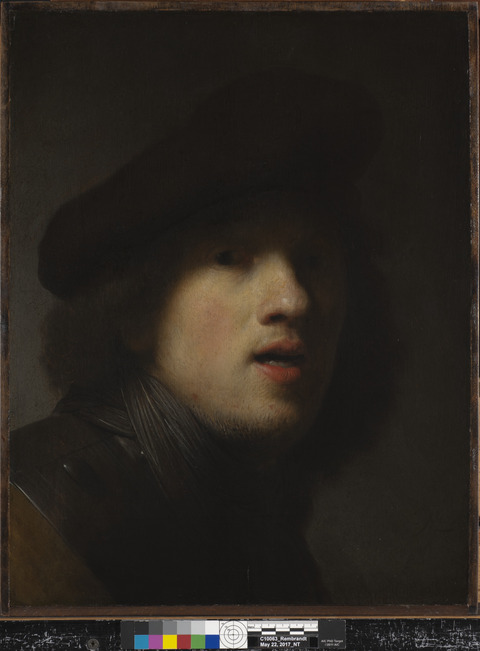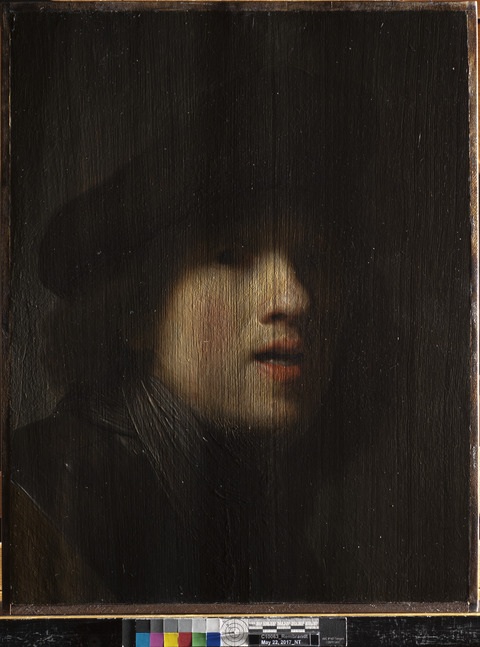Overview
Accession number: C10063
Artist: Rembrandt van Rijn
Title: Self-Portrait
Materials: Oil (untested) on Baltic oak panel
Date of creation: About 1629
Previous number/accession number: None
Dimensions: 44.1 × 34.5 cm
Conservator/examiner: Roxane Sperber with contributions from David Miller
Examination completed: 2018
Distinguishing Marks
Front:
Item 1: Signature “RHL” in black paint, lower right quadrant (tech. figs. 1, 2).1
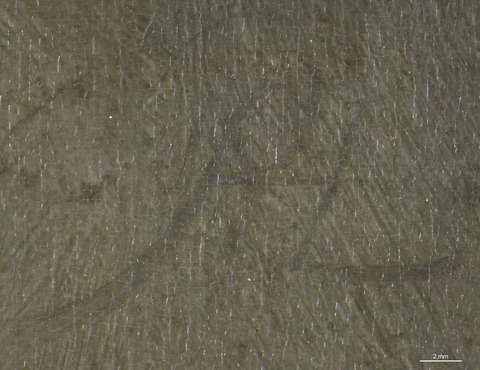
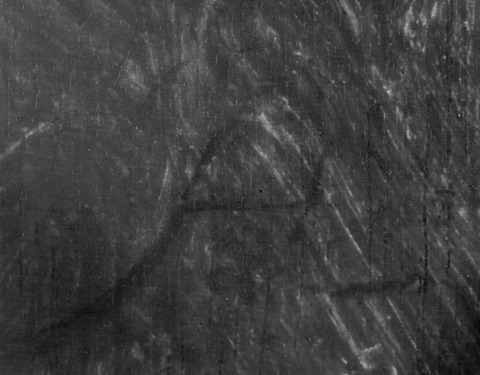

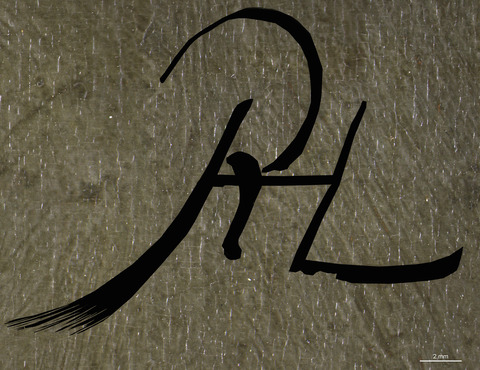
Back:
None
Summary of Treatment History
Physical evidence suggests the panel was thinned and cradled before 1951, and framing strips on all four sides were added to the painting. In 1951, shortly before the work was acquired by Dr. Clowes, it was cleaned by Edward O. Korany, a restorer of paintings in New York.2 The 1951 treatment included the application of a natural resin varnish and minor surface retouching.3 The effect was evidently dramatic, as Jakob Rosenberg, curator of prints at the Fogg Art Museum at Harvard, commented in a letter to Frederick Mont that “from the photograph alone (taken before the cleaning of the picture) I was not fully convinced about its authenticity. But after having seen it now, under such excellent conditions, I believe that it is by Rembrandt."4
Dr. Clowes closely monitored the condition of the painting, as is evidenced by his letter to the Newhouse Galleries. On 29 May 1951, he wrote to Clyde Newhouse: “I have noted, as you probably did, that in spite of the fact that the Rembrandt self portrait is cradled there is already a slight warping or wave, which is most pronounced at the top of the picture, and I certainly have no intention of risking anything that might make this condition worse.” This prompted Clowes to have the painting glazed with “new non-reflecting glass."5
Several years later, Clowes discussed lending the painting to New York, Toledo, and Toronto, writing “since its return I have noticed a certain amount of opacity, particularly over a substantial area of the hat, which now seems to be spreading downward. I think it must be due to some disturbance of the varnish, possibly resulting from exposure to variation in temperature of some other cause….I am pretty confident that the trouble is only in the varnish and that it can probably be taken care of easily, but I think it is a matter of such great importance that I want to get your advice as to what we should do about it and particularly to whom it should be sent so as to be sure that the defective varnish is properly taken off and a thin coat of the most suitable type put on."6 Clyde Newhouse responded to his concerns, saying that his assistant Benny would come to Indianapolis and take the painting to New York to remove the bloom.7 This intervention appears to have resolved the issue.8
Documentation suggests a series of condition assessments and treatments were carried out on the collection around the time the works were moved from the Clowes' residence to the IMA in 1971. In a condition report by Paul Spheeris in October of that year, likely carried out before the paintings were relocated, he recommended cleaning for the sake of its appearance but not for the safety of the painting.9
A second condition assessment was carried out upon arrival of the paintings at the IMA. This assessment describes the work as being in good condition, and no work was deemed necessary. An X-radiograph of the painting was made at this time.10
In 1974, a condition assessment, treatment, and investigation of the collection was carried out by the Intermuseum Conservation Association at Oberlin College. Their report described this painting as having a heavy natural resin varnish that had discolored to a yellow and noted a hazy white surface film, presumably the blooming also noted by Clowes. Loosening and waxing the cradle members and removing the surface haze was recommended.11 A memorandum explaining the charges for this work suggest their recommendations were indeed carried out.12
In 1996, a memorandum summarizing treatment and examination of the Clowes Collection from the time it entered the collection notes that the painting was, at that time, the subject of extensive ongoing technical investigation. It also notes that in 1992 cracks and loses were consolidated, inpainting was carried out, and a microclimate was created before loaning the painting to Japan.13
The painting was inspected in the Clowes Collection annual survey from 2011 to 2020.
Current Condition Summary
The painting is in generally good condition. Previous problems with the varnish blooming, visible in the 1950s through the 1980s,14 seem to have been resolved by placing the painting in a sealed microclimate. Retouching from the 1951 campaign has, however, discolored over time and become more noticeable. This is particularly distracting in the forehead and hair of the figure.
Methods of Examination, Imaging, and Analysis
| Examination/Imaging | Analysis (no sample required) | Analysis (sample required) |
|---|---|---|
Unaided eye | Dendrochronology | Microchemical analysis |
Optical microscopy | Wood identification | Fiber ID |
Incident light | Microchemical analysis | Cross-section sampling |
Raking light | Thread count analysis | Dispersed pigment sample |
Reflected/specular light | X-ray fluorescence spectroscopy (XRF) | Fourier-transform infrared spectroscopy (FTIR) |
Transmitted light | Macro X-ray fluorescence scanning (MA-XRF) | Raman microspectroscopy |
Ultraviolet-induced visible fluorescence (UV) | ||
Infrared reflectography (IRR) | Gas chromatography–mass spectrometry (GC-MS) | |
Infrared transmittography (IRT) | Scanning electron microscope -energy dispersive X-ray spectroscopy (SEM-EDS) | |
Infrared luminescence | Other: | |
X-radiography |
Technical Examination
Description of Support:
Analyzed Observed
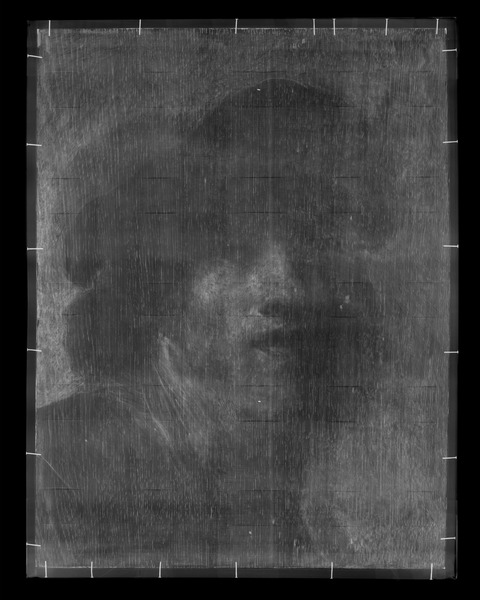
Material (fabric, wood, metal, dendrochronology results, fiber ID information, etc.):
The painting is executed on an oak panel with vertical grain. The single board was cut slightly conically so there are more rings at the bottom than the top.15 Dendrochronologist Peter Klein identified the panel wood as originating in the Baltic/Polish region and dated the rings to between 1408 and 1581. Considering the sapwood statistics for Eastern Europe, Klein judged the earliest possible felling date to be 1590. Accounting for a minimum of two years of seasoning, 1592 would be the earliest possible date for the painting. A more plausible date of creation would be 1598 or thereafter.16 Ray flecks are visible on the back of the panel suggesting it was radially sawn.
A radiopaque line is visible through the center of the panel, passing through the figure’s nostril and chin. This is likely an indentation in the panel from a ring with a flaw in it caused by frost damage or physical damage to the tree that prevented the ring from converting into heartwood.17 When evening out the panel, a thicker buildup of ground was necessary to smooth this indentation causing it to appear more radiopaque than other areas (tech. fig. 3).
The use of a panel support is consistent with Rembrandt’s paintings from before 1631, which excluding a few small painted works on copper, are painted entirely on panel.18
Characteristics of Construction / Fabrication (cusping, beveled edges of panels, seams, joins, battens):
The panel has been thinned to 0.6 cm, likely before the addition of a cradle. The painting probably had beveled edges before it was thinned, as was typical of Rembrandt’s panels.19 The panel was fitted with four edge strips (0.8 cm wide). The edge strips were glued with a strong glue that is not water soluble and then nailed.20 The bottom edge strip was removed when the painting was analyzed for dendrochronology in 1999. When it was put back in place, it was tacked, but not glued.
Thickness (for panels or boards):
0.6 cm
Production/Dealer’s Marks:
None
Attachment to Auxiliary Support:
A cradle with five fixed vertical members and five movable members has been adhered to the back. The cradle is well-crafted and adhered to the thinned panel with an adhesive that can be seen in some areas along the cradle panel interface. Three of the movable horizontal members have seized up and no longer move. The two outer fixed members and the central member are 3.8 cm and 4.5 cm wide, respectively. The two other vertical members are 3 cm wide. The horizontal members are 2.6 cm wide. A dark brown stain was applied to the cradle and the back of the thinned panel.
Given the design of the cradle and the provenance of the painting, it is likely that the cradle was added around 1840 when the panel was sold in Vienna. In mid-nineteenth-century Vienna, movable cradles in the style of French cabinet maker and restorer Jean-Louis Hacquin and his son François-Toussaint Hacquin were popularized through several articles.21 Indeed, a cradle applied by François-Toussaint Hacquin in 1825 has slats with ornamented molding much like that used on the Clowes painting.22 According to oral accounts, most of the panel paintings in the Kunsthistorisches Museum were thinned and cradled between 1825 and 1835 to create a flat surface.23 As there are no splits or worm damage, there does not seem to be a condition-related reason for cradling the Clowes panel.
Auxiliary Support:
Original Not original Not able to discern None
Condition of Support
The support is in good condition. Despite having been thinned and cradled, there are no splits, and the panel is stable. This may be due to the well-seasoned, carefully prepared, radially cut board. There is no evidence of insect damage.
The central member of the cradle has six holes, perhaps from a previous framing mechanism. There are several dents and scuffs to the vertical members of the cradle.
Description of Ground
Analyzed Observed
A cross-section sample was taken from a loss along the left edge of the painting (tech. fig. 4) in order to analyze the preparatory layers.24 The ground is a thinly applied, off-white color composed of calcium carbonate likely in animal skin glue (medium untested) (tech. figs. 5-7). This ground structure is consistent with that found on other panels from Rembrandt’s studio and is typical of seventeenth-century Dutch panel makers.25

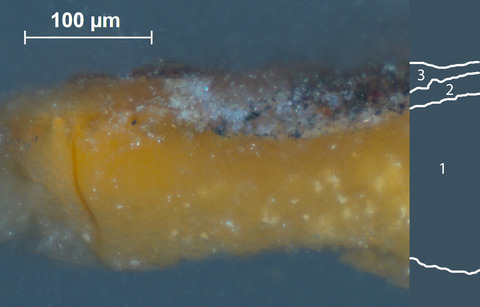
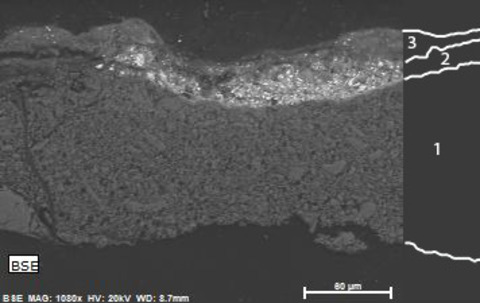
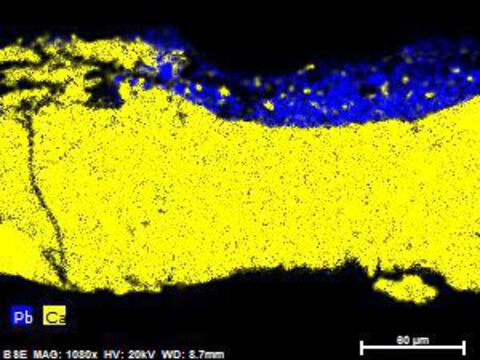
Over the calcium carbonate ground there is a second layer (imprimatura) composed of lead white, charcoal black, calcium carbonate, and a small quantity of earth pigments. This layer is likely bound in oil (untested) and served to seal off the panel and provide a midtone on which to paint. A study of Rembrandt’s grounds found a thin, lead-white- containing layer to be present over the chalk ground in all cases.26
Materials/Binding Medium:
Animal skin glue (untested)
Color:
White ground with a light grayish-brown imprimatura
Application:
The painting has an evenly applied ground. The ground was likely applied by the panel maker before Rembrandt acquired the panel.27 The imprimatura was applied evenly, making the grain in the wood visible in X-radiography (see tech. fig. 3).
Thickness:
Thin
Sizing:
Likely animal skin glue (untested)
Character and Appearance (Does texture of support remain detectable / prominent?):
The ground was applied smoothly and thinly. There is no detectable texture from the ground.
Condition of Ground
The ground is in good condition. There is a minor crack along the bottom edge that penetrates the ground and paint but not the wood. The crack aligns with the center of the central vertical member of the cradle. There is a small loss along the top edge.
Description of Composition Planning
Methods of Analysis:
Surface observation (unaided or with magnification)
Infrared reflectography (IRR)
X-radiography
Analysis Parameters:
| X-radiography equipment | GE Inspection Technologies Type: ERESCO 200MFR 3.1, Tube S/N: MIR 201E 58-2812, EN 12543: 1.0mm, Filter: 0.8mm Be + 2mm Al |
|---|---|
| KV: | 26 |
| mA: | 3.0 |
| Exposure time (s) | 60 |
| Distance from X-ray tube: | 36” |
| IRR equipment and wavelength | Opus Instruments Osiris A1 infrared camera with InGaAs array detector operating at a wavelength of 0.9-1.7µm. |
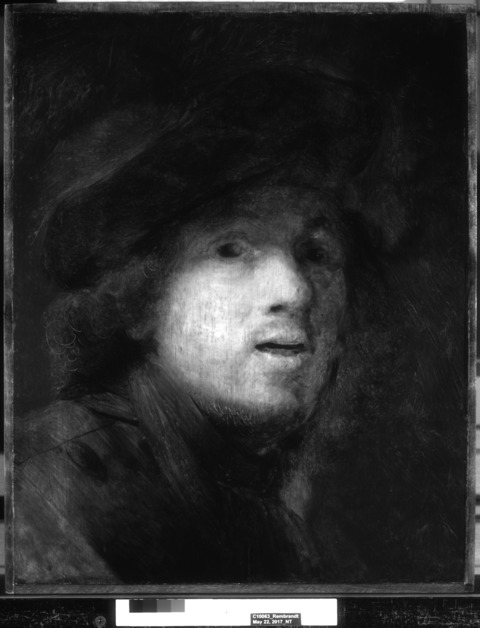
Medium/Technique:
No carbon-containing underdrawing is visible in the infrared reflectogram (tech. fig. 8). This is unsurprising given that Rembrandt did not draw his compositions on his painting supports, preferring to establish his compositions in paint.28
It is clear that much of the painting has a translucent redish-brown toning layer that appears warmer than the lead-white and carbon black imprimatura. This layer can be seen in areas where the artist has scratched into the paint, such as the hair (tech. fig. 9) and beard (tech. fig. 15).29 Although not visible in cross sections from the edge of the painting, the artist seems to have toned much of the area under the figure with this warm toning layer. This likely occurred during the planing stage of the painting. X-ray fluorescence spectroscopy (XRF) detected the presence of manganese in these areas, while no manganese was detected in the ground or imprimatura layer (see Description of Ground). This suggests the redish-brown toning layer likely contain umber pigments (see Table 1, sample 11, 12).
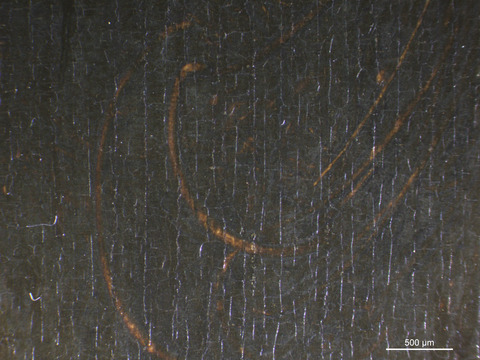
Over the midtone imprimatura and toning layer, compositional elements appear to have been demarcated in paint. Infrared reflectography shows infrared-absorbing paint outlining the eye, profile of the figure’s nose, side of the face, outline of the hat, and chest. These strokes do not correspond with paint strokes visible in the final composition, as they are covered by upper layers of paint. There may have been further outlining that is blocked by upper layers of paint that absorb in the infrared region.
Pentimenti:
During the planning phase, the position of the hat was changed. This change is visible in both the X-radiograph and infrared image. The hat appears to have originally had a different shape and was oriented differently on the figure’s head. This change appears to have happened early in the planning phase of the painting process as evidence of the change is not visible in the final version, even under magnification. This reworking suggests that the Clowes painting is the original version of the composition.30 In 2020, a similar version of this composition, titled Portrait of the artist in a black cap, scarf and steel gorget, was sold at Christies. This work was attributed by Christies to a student of Rembrandt, and dendrochronological analysis by Art Analysis & Research Inc. suggested that the panel for this version was available for use after about 1631.31
Description of Paint
Analyzed Observed
Application and Technique:
Rembrandt utilized the warm toning layer to create chiaroscuro that enhances the drama of the moment being portrayed. The contrast of sharply articulated highlights in thick dabs of paint and subtly modulated tones of shadow masterfully creates the illusion of movement as the artist turns in surprise, his lips open as if about to speak.
After the initial outlining of the composition (see Description of Composition Planning), areas of color were blocked in using directly applied opaque paint to create the hair, clothes, and shadows of the face. The modulating grays of the background were painted at the same time as the figure, as is demonstrated by the wet-in-wet strokes of paint along the border of the hair and background (tech. fig. 10). The background was painted in energetic brush strokes that are clearly visible in the infrared image (tech. fig. 8). These strokes are painted with a wide brush contrasting the smaller brushstrokes used to paint the skin of the figure’s face.
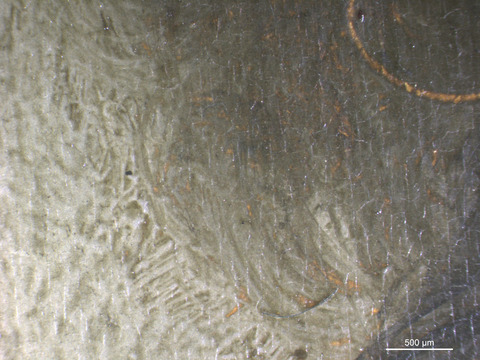
The shadows in the face were painted in a thin, evenly applied layer of cool, opaque paint that was directly painted onto the warm toning layer. In some areas, the toned layer was left exposed and in other areas it can be seen through the thin gray paint. The contrasting warmth of the toning layer and cool gray paint creates subtle modulation in the shadow of the artist’s face. The thin, even application of paint in the shadows throughout the picture mimics the way the eye sees in low light and creates a realistic illusion.
The transition from highlight to shadow was carefully planned before painting began in order to create crisp, well-defined transitions.32 A cool half-tone was used to aid the transition from shadow to highlight and help create a seamless illusion of form (tech. fig. 11).33
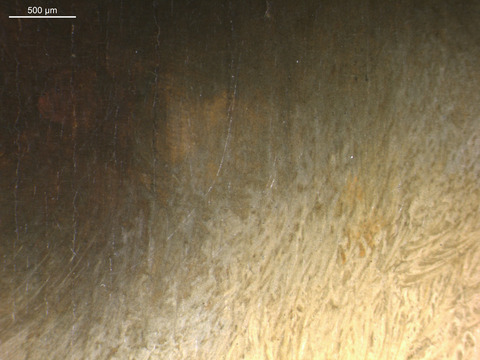
The light area of the face was painted in loose, rapid brush strokes that further contrast the smooth even application in the shadows. The midtones in the skin alternate between a cool gray and a warm yellowish-pink. Strokes of rosy-red paint in the cheeks, nose, and lips give the artist a youthful complexion.
Highlights were applied to the nose and lips in thick dabs of paint (tech. fig. 12). Highlights were also painted on the scarf to create detailing that subtly fades into shadow. Highlights applied to the gorget enhance the illusion of reflective metal (tech. fig. 13). The deepest darks were applied in thick strokes of black paint. A single stroke of thick black paint between the figure’s lips (tech. fig. 14) gives the illusion of depth in the mouth. The eyes are simply painted with a few brown outlines and dabs of black paint, barely differentiable from the shadowy background.
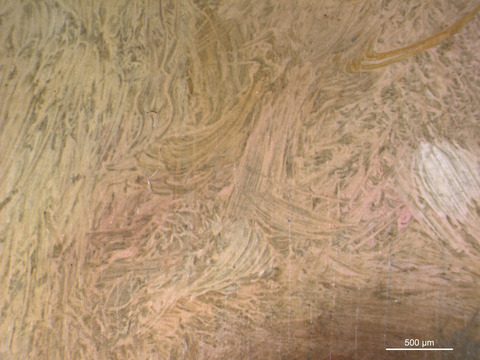
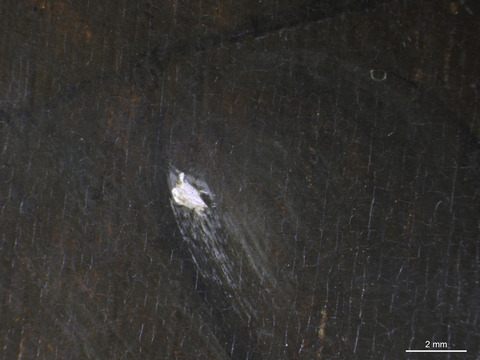
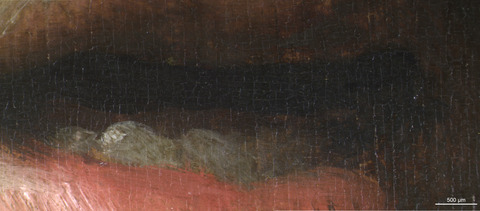
Final detailing was scratched into the paint while it was still wet. The artist used a small brush to articulate the stubble of his beard and a pointed tool, perhaps the back of the brush, to accentuate this effect and create “c”-shaped detailing in the hair (tech. fig. 15). By scratching away the paint layers to expose the reddish toning layer, the beard and hair take on an auburn hue.34
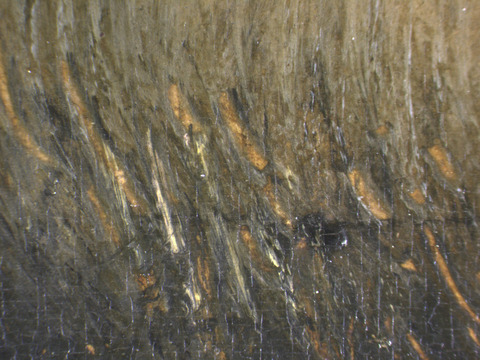
Rembrandt painted blemishes on his chin and along his jaw line, indicating red irritation with a stroke or two of pink paint (tech. figs. 16, 17). Interestingly, such details were frequently omitted by copyists of Rembrandt’s self-portraits.35
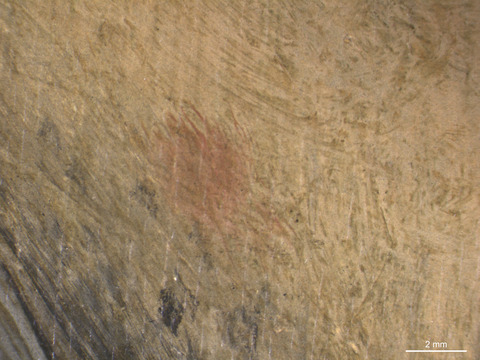

The RHL monogram was painted in the lower-right corner using gray paint. The monogram conforms to that used by Rembrandt between late 1627 and early 1629.36 Ernst van de Wetering describes the signature as being applied while the painting was still wet.37 This is not immediately apparent under the microscope as the delicately applied signature does not appear to disrupt the underlying paint layer (tech. fig. 18). It is possible that the application was so light that it did not disrupt the wet paint as did occur in other areas of the painting where more vigorous brush work created a clear wet-in-wet effect (see tech. fig. 10). Alternatively, the monogram may have been added shortly after the work was finished when the background was dry to the touch. The signature is contemporaneous to the rest of the painting as the craquelure pattern is consistent through both the signature and the paint below it (see Distinguishing Marks).
Painting Tools:
Medium-sized brush, small brush, pointed tool
Binding Media:
Oil (untested)
Color Palette:
XRF and energy-dispersive X-ray spectroscopy (EDS) were conducted to determine which elements are present and thus what pigments the artist may have used (tech. fig. 19). This analysis suggests the painting was created using a limited palette composed of a range of iron oxide earth pigments, carbon black, vermilion, and a copper-containing green (or blue). Lead white is present throughout the painting, even in the darks, which is due to its presence in the lead-white-rich imprimatura. Calcium was also detected in most locations due to its presence in the ground.
The background of the figure is painted using modulating gray tones, composed of lead white, iron oxide pigments, and carbon black. A copper-containing green (or blue) pigment was also detected using XRF.
Both background spots analyzed contain the same elements with the darker area of the background (table 1, sample 1) containing a stronger peak from copper than the lighter area (Table 1, sample 10). Both spots contain more copper than most other areas of the painting where only traces of copper are present. A strong peak for copper was also detected in the shadowy area above the eye (table 1, sample 14). This area has a cool grayish-green tone suggesting a copper-containing green or blue pigment was mixed into the shadow of the skin to enhance the cool tone. Azurite was used to similar effect in the shadow of the hand in Saskia van Uylenburgh in Arcadian Costume at the National Gallery in London.38 No copper was detected in the greenish-brown sleeve. The sleeve is painted primarily using lead white and a combination of iron oxide earth pigments.
The highlighted areas of flesh were painted using primarily lead white and iron oxide earth pigments with a small amount of vermilion in the cheeks. Mercury was detected in the lips, suggesting the use of vermilion there too.
No phosphorous was detected in the black hat (table 1, sample 2) indicating that it was painted using carbon black, as opposed to Rembrandt’s favored bone black.39 The scarf was painted using primarily lead white and a combination of iron oxide earth pigments.
XRF Analysis:
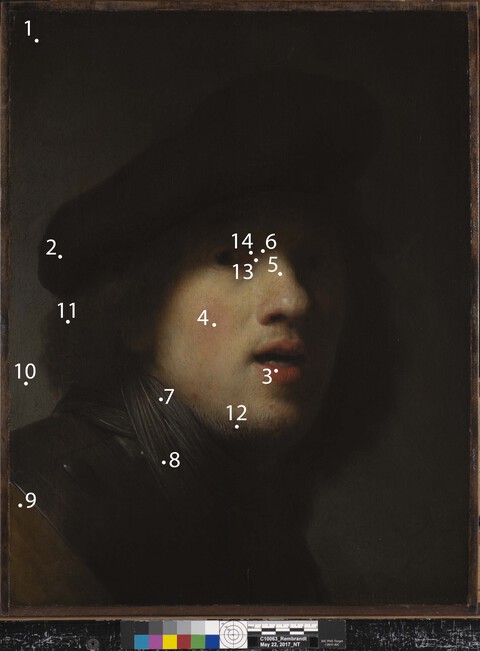
| Sample | Location | Elements | Possible Pigments |
|---|---|---|---|
| 1 | Grayish green background (3 cm down 3 cm from left) | Major: Pb Minor: Fe, Cu Trace: Hg, Ca, Mn | Iron oxide (earth pigments), lead white, calcium carbonate (from ground), copper-containing blue or green, trace of vermilion |
| 2 | Black hat (18 cm down 4.7 cm from left) | Major: Pb Minor: Fe Trace: Ca, Mn | Carbon black (not bone black), iron oxide (earth pigments), lead white, calcium carbonate (from ground) |
| 3 | Red lip (26.5 cm down 20 cm from left) | Major: Pb, Hg Minor: Fe Trace: Ca, Mn, Cu | Vermilion, lead white, iron oxide (earth pigments), calcium carbonate (from ground), trace of copper-containing blue or green pigment |
| 4 | Rosy cheek (24cm down 16 cm from left) | Major: Pb Minor: Fe, Hg Trace: Cu, Ca | Lead white, iron oxide (earth pigments), vermilion, trace of calcium carbonate (from ground), trace of copper-containing blue or green pigment |
| 5 | Nose (19.5 cm down 20.5 cm from left) | Major: Pb Minor: Fe Trace: Hg | Lead white, iron oxide (earth pigments), vermilion, trace of calcium carbonate (from ground) |
| 6 | Cool transition tone (19 cm down 20 cm from left) | Major: Pb Minor: Fe Trace: Ca | Iron oxide (earth pigments), lead white, trace of calcium carbonate (from ground), likely carbon black |
| 7 | Gray stripe on scarf (29 cm down 12 cm from left) | Major: Pb Minor: Trace: Fe, Ca | Iron oxide (earth pigments), lead white, trace of calcium carbonate (from ground), likely carbon black |
| 8 | Dark stripe on scarf (33 cm down 12 cm from left) | Major: Pb Minor: Fe, Ca Trace: Mn, Cu | Iron oxide (earth pigments), lead white, trace of calcium carbonate (from ground), likely carbon black, trace of copper-containing blue or green |
| 9 | Green sleeve (36 down 1.5 cm from left) | Major: Pb, Fe Minor: Ca Trace: Ti, Mn, Cu | Iron oxide (earth pigments including umber), lead white, trace of calcium carbonate (from ground), likely carbon black, trace of copper-containing blue or green, trace of titanium and manganese likely from earth pigments |
| 10 | Light gray background (27.5 cm down 1.5 cm from left) | Major: Pb Minor: Fe Trace: Ca, Mn, Cu | Iron oxide (earth pigments including umber), lead white, trace of calcium carbonate (from ground), likely carbon black, trace of copper-containing blue or green |
| 11 | Reddish-brown underpainting in beard (31 cm down 16.5 cm from left) | Major: Pb Minor: Ca, Fe Trace: Mn | Iron oxide (earth pigments), lead white (from imprimatura), trace of calcium carbonate (from ground) |
| 12 | Reddish-brown underpainting in hair (23 cm down 5 cm from left) | Major: Pb Minor: Fe, Ca Trace: Mn | Iron oxide (earth pigments), lead white (from imprimatura), trace of calcium carbonate (from ground) |
| 13 | Exposed ground near proper right eye (18.5 cm down 18.5 cm from left) | Major: Pb Minor: Fe Trace: Ca, Mn | Iron oxide (earth pigments), lead white, trace of calcium carbonate (from ground) |
| 14 | Shadow near proper right eye (18.5 cm down 18 cm from left) | Major: Pb, Fe Minor: Cu, Mn Trace: Ca, Hg | Iron oxide (earth pigments including umber), lead white, copper-containing green or blue pigment, trace of calcium carbonate (from ground), trace of vermilion |
Table 1: Results of X-ray fluorescence analysis conducted with a Bruker Artax microfocus XRF with rhodium tube, silicon-drift detector, and polycapillary focusing lens (~100μm spot).
*Major, minor, trace quantities are based on XRF signal strength not quantitative analysis
**Locations were measured from the edge of the wooden addition.
Surface Appearance:
The areas of lights are built up in several layers of paint and have a low impasto. The areas of shadow are smooth and even.
Description of Varnish/Surface Coating
Analyzed Observed Documented
| Type of Varnish | Application |
|---|---|
Natural resin | Spray applied |
Synthetic resin/other | Brush applied |
Multiple Layers observed | Undetermined |
No coating detected |
The painting is coated in a natural resin varnish that was applied after the work was cleaned in 1951, and retouching along the edges of the painting and across the surface was applied at this time. Retouching appears to be covering primarily minor abrasion. An older campaign of retouching, such as retouching found on the figure’s upper lip, is not visible in ultraviolet-induced visible fluorescence as it is under the natural resin varnish (tech. fig. 20). In the late 1970s, a synthetic varnish was sprayed on the painting.40
Condition of Varnish/Surface Coating
The retouching applied during the 1951 treatment is now discolored and is thus visible in both ultraviolet-induced visible fluorescence and with the naked eye (tech. fig. 21). The natural resin varnish is slightly yellowed but not profoundly so. A microscopic crack pattern exists in some areas of the varnish that does not correspond to the underlying paint layer. The varnish has had problems with blooming,41 which may relate to this network of cracking. However, the work is presently housed in a microclimate chamber that seems to have resolved this problem.

Description of Frame
Original/first frame
Period frame
Authenticity cannot be determined at this time/ further art historical research necessary
Reproduction frame (fabricated in the style of)
Replica frame (copy of an existing period frame)
Modern frame
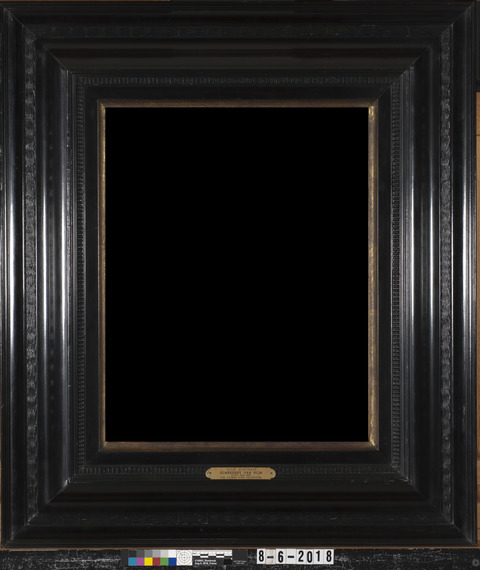

Frame Dimensions:
Outside frame dimensions: 69.5 × 60.5 cm
Sight size: 42.5 × 33 cm
Rebate dimensions: 46.5 × 37 cm
Distinguishing Marks:
Item 2. Paper label, lower-left corner of the frame, back (tech. fig. 24)
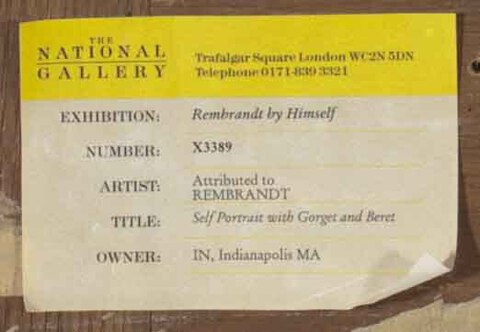
Item 3. Paper labels, upper-left corner of the frame, back (tech. fig. 25)
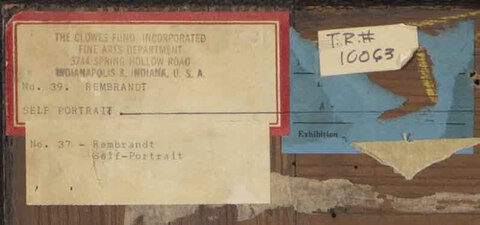
Item 4. Paper label, upper-right corner of the frame, back (tech. fig. 26)
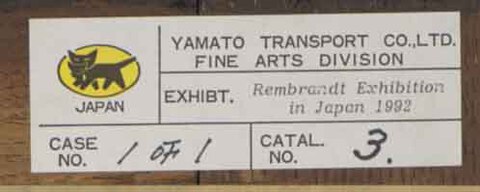
Description of Molding/Profile:
The frame is a modern wooden frame in the style of a Dutch seventeenth-century frame (tech. fig. 22). The frame is composed of four members with mitered corner joins. The surface has been painted with a glossy black paint. The innermost decorative element is gilded. There is a build-out on the back to accommodate the microclimate chamber. The rebate is lined with felt tape (tech. fig. 23).
Condition of Frame
The frame is in excellent condition. The gilding is quite dusty giving it a dull black appearance. There may be a toning layer, perhaps glue, that was intended to dull the gold but has since attracted dirt.
Notes
-
The signature matches that used by Rembrandt in 1628/9. Ernst van de Wetering, “Rembrandt laughing c. 1628—a painting resurfaces,” De Kroniek van het Rembrandthuis (2007): 24. ↩︎
-
Letter from Edward O. Korany dated 15 May 1951 certifies that the restorer “recently cleaned and carefully examined the painting” and that that painting was in “exceptionally perfect condition, and that the signature is absolutely genuine.” This letter is dated shortly after Dr. Clowes purchased the painting from Newhouse Galleries and was presumably intended to provide certification of the restoration treatment and authenticity of the work. File C10063, Clowes Registration Archive, Indianapolis Museum of Art at Newfields. ↩︎
-
David Miller, “Conservation Laboratory Examination Techniques and Conservator’s Report,” Perceptions 1 (1981): 27. ↩︎
-
Letter from Jakob Rosenberg to Mr. Frederick Mont, 10 May 1951, File C10063, Clowes Registration Archive, Indianapolis Museum of Art at Newfields. ↩︎
-
Letter from G.H.A. Clowes to Clyde Newhouse, 29 May 1951, Correspondence Files, Clowes Registration Archive, Indianapolis Museum of Art at Newfields. ↩︎
-
Letter from G.H.A. Clowes to Bert Newhouse, 17 November 1955, Correspondence Files, Clowes Registration Archive, Indianapolis Museum of Art at Newfields. ↩︎
-
Letter from Clyde Newhouse to G.H.A. Clowes, 22 November 1955, Correspondence Files, Clowes Registration Archive, Indianapolis Museum of Art at Newfields. ↩︎
-
Letter from BMN Newhouse to G.H.A. Clowes, 20 January 1956, Correspondence Files, Clowes Registration Archive, Indianapolis Museum of Art at Newfields. ↩︎
-
Paul A.J. Spheeris, “Conservation Report on the Condition of the Clowes Collection,” 25 October 1971, Conservation Department Files, Indianapolis Museum of Art at Newfields. ↩︎
-
Martin Radecki, Clowes Collection condition assessment, undated (after October 1971), Conservation Department Files, Indianapolis Museum of Art at Newfields. ↩︎
-
Intermuseum Conservation Association, “Clowes Collection Conservation Report,” C10063, 8-10 April 1974, Conservation Department Files, Indianapolis Museum of Art at Newfields. ↩︎
-
Memorandum from Carl J. Weinhardt to Martin J. Radecki, “Charges for Conservation of Objects in the Clowes Collection,” 15 February 1974, Conservation Department Files, Indianapolis Museum of Art at Newfields. ↩︎
-
Memorandum from Martin Radecki to Bret Waller, “Conservation work on Clowes Fund Collection,” 16 February 1996, Conservation Department Files, Indianapolis Museum of Art at Newfields. ↩︎
-
David Miller, “Conservation Laboratory Examination Techniques and Conservator’s Report,” Perceptions 1 (1981): 27. ↩︎
-
Ian Tyers, email message to author, 4 September 2018. ↩︎
-
Peter Klein, dendrochronological analysis report, C10063, 1999, Conservation Department Files, Indianapolis Museum of Art at Newfields. ↩︎
-
Ian Tyers, email message to author, 4 September 2018. ↩︎
-
Ernst van de Wetering, Rembrandt: The Painter at Work (Amsterdam: Amsterdam University Press, 2009), 11. ↩︎
-
Ernst van de Wetering, Rembrandt: the painter at work (Amsterdam: Amsterdam University Press, 2009), 11. ↩︎
-
David Miller, notes on Rembrandt Self-Portrait, C10063,17 June 1994, Conservation Department Files, Indianapolis Museum of Art at Newfields. ↩︎
-
Ulrich Schiessl, “History of Structural Panel Painting Conservation in Austria, Germany, and Switzerland,” in The Structural Conservation of Panel Paintings: Proceedings of a Symposium at the J. Paul Getty Museum, 24–28 April 1995, ed. Kathleen Dardes and Andrea Rothe (Los Angeles, CA: Getty Conservation Institute, 1998), 217, http://hdl.handle.net/10020/gci_pubs/panelpaintings
For discussion of Jean-Louis Hacquin and François-Toussaint Hacquin see Ségolène Bergeon, Gilberte Emile-Mâle, Claude Huot, and Odile Baÿ, “The Restoration of Wooden Painting Supports Two Hundred Years of History in France” in The Structural Conservation of Panel Paintings: Proceedings of a Symposium at the J. Paul Getty Museum, 24-28 April 1995, ed. Kathleen Dardes and Andrea Rothe (Los Angeles, CA: Getty Conservation Institute, 1998), 264–288: http://hdl.handle.net/10020/gci_pubs/panelpaintings ↩︎
-
Ségolène Bergeon, Gilberte Emile-Mâle, Claude Huot, and Odile Baÿ, “The Restoration of Wooden Painting Supports Two Hundred Years of History in France,” in The Structural Conservation of Panel Paintings: Proceedings of a Symposium at the J. Paul Getty Museum, 24–28 April 1995, ed. Kathleen Dardes and Andrea Rothe (Los Angeles, CA: Getty Conservation Institute, 1998), 270, http://hdl.handle.net/10020/gci_pubs/panelpaintings ↩︎
-
Ulrich Schiessl, “History of Structural Panel Painting Conservation in Austria, Germany, and Switzerland,” in The Structural Conservation of Panel Paintings: Proceedings of a Symposium at the J. Paul Getty Museum, 24–28 April 1995, ed. Kathleen Dardes and Andrea Rothe (Los Angeles, CA: Getty Conservation Institute, 1998), 217, http://hdl.handle.net/10020/gci_pubs/panelpaintings ↩︎
-
Additional cross-section samples were taken as part of this technical study. For further analysis see IMA records. ↩︎
-
David Bomford, Christopher Brown, and Ashok Roy, Art in the Making: Rembrandt (London: National Gallery Publications, 1991), 27. ↩︎
-
See C. Karin and M. Groen, “Grounds in Rembrandt’s Workshop and in Paintings by His Contemporaries,” in A Corpus of Rembrandt Painting Volume VI, ed. Ernst van de Wetering (Dordrecht : Springer, 2005), 319. ↩︎
-
Ernst van de Wetering, Rembrandt: The Painter at Work (Amsterdam: Amsterdam University Press, 2009), 21. ↩︎
-
Ernst van de Wetering, Rembrandt: The Painter at Work (Amsterdam: Amsterdam University Press, 2009), 23. ↩︎
-
This layer has been described by Edwin Buijsen as a “red layer of underpainting.” Edwin Buijsen, Rembrandt by Himself, ed. Christopher White, and Quentin Buvelot (London: National Gallery Publications Ltd, 1999), 100. ↩︎
-
David Miller, “Conservation Laboratory Examination Techniques and Conservator’s Report”, Perceptions 1 (1981): 28. Edwin Buijsen, Rembrandt by Himself, ed. Christopher White and Quentin Buvelot (London: National Gallery Publications Ltd, 1999), 100. ↩︎
-
Art Analysis & Research in London, email message to Gregory D. Smith, 15 June 2020. ↩︎
-
Karin N. Groen notes that the lights and shadows in Rembrandt’s compositions were established at an early stage in the painting process. This is certainly the case in the Clowes work. Karin N. Groen, “Earth Matters: The Origin of the Material Used for the Preparation of the Night Watch and Many Other Canvases in Rembrandt’s Workshop after 1640,” Art Matters 3 (2005): 139. ↩︎
-
See discussion of the cool half tone in David Bomford, Christopher Brown, and Ashok Roy, Art in the Making: Rembrandt (London: National Gallery Publications, 1991), 33. ↩︎
-
The identical technique was sued in self-portrait from 1628, now in the Rijksmuseum (Self Portrait as a Young Man inv. no. A 4691) and another work from 1629, now in the Alte Pinakothek Berlin (Self Portrait as a Young Man inv. no. 11427) ↩︎
-
Stepahanie Dickey, Rembrandt Face to Face (Indianapolis: Indianapolis Museum of Art, 2006), 32. ↩︎
-
Ernst van de Wetering, “Rembrandt laughing c. 1628—a painting resurfaces,” De Kroniek van het Rembrandthuis (2007): 24. ↩︎
-
Ernst van de Wetering, “Rembrandt laughing c. 1628—a painting resurfaces,” De Kroniek van het Rembrandthuis (2007): 24. See also Ernst van de Wetering, “Rembrandt’s Self-Portrait: Problems of Authenticity and Function,” in A Corpus of Rembrandt Painting Volume VI, ed. Ernst van de Wetering (Dordrecht : Springer, 2005), 164, and Ernst van de Wetering, “Corrigenda et Addenda,” in A Corpus of Rembrandt Painting Volume VI, ed. Ernst van de Wetering (Dordrecht : Springer, 2005), I A 22/ Br. 3, 600. ↩︎
-
David Bomford, Christopher Brown, and Ashok Roy, Art in the Making: Rembrandt (London: National Gallery Publications, 1991), 25. ↩︎
-
David Bomford, Christopher Brown, and Ashok Roy, Art in the Making: Rembrandt (London: National Gallery Publications, 1991), 24. ↩︎
-
David Miller, “Conservation Laboratory Examination Techniques and Conservator’s Report”, Perceptions 1 (1981): 27. ↩︎
-
This was observed as early as 1955. Letter from Clyde Newhouse to G.H.A. Clowes, 22 November 1955, Correspondence Files, Clowes Registration Archive, Indianapolis Museum of Art at Newfields. ↩︎
Additional Images
